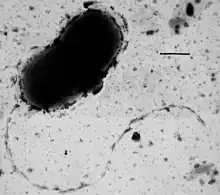Desulfovibrio
| Desulfovibrio | |
|---|---|
 | |
| Desulfovibrio vulgaris | |
| Scientific classification | |
| Domain: | |
| Phylum: | |
| Class: | |
| Order: | |
| Family: | |
| Genus: | Desulfovibrio Kluyver & van Niel 1936 |
| Species | |
|
D. acrylicus | |
Desulfovibrio is a genus of Gram-negative sulfate-reducing bacteria. Desulfovibrio species are commonly found in aquatic environments with high levels of organic material, as well as in water-logged soils, and form major community members of extreme oligotrophic habitats such as deep granitic fractured rock aquifers.
Like other sulfate-reducing bacteria, Desulfovibrio was long considered to be obligately anaerobic. This is not strictly correct: while growth may be limited, these bacteria can survive in O2-rich environments. These types of bacteria are known as aerotolerant.
Some Desulfovibrio species have in recent years been shown to have bioremediation potential for toxic radionuclides such as uranium by a reductive bioaccumulation process.
References
- ↑ Parte, A.C. "Desulfovibrio". LPSN.
- Madigan M; Martinko J, eds. (2005). Brock Biology of Microorganisms (11th ed.). Prentice Hall. ISBN 0-13-144329-1.
External links
- Amrani, Amira; Bergon, Aurelie; Holota, Helene; Tamburini, Christian; Garel, Marc; Ollivier, Bernard; Imbert, Jean; Dolla, Alain (12 September 2014). "Transcriptomics Reveal Several Gene Expression Patterns in the Piezophile Desulfovibrio hydrothermalis in Response to Hydrostatic Pressure". PLOS ONE. 9 (9): e106831. Bibcode:2014PLoSO...9j6831A. doi:10.1371/journal.pone.0106831. PMC 4162548. PMID 25215865.
- Czechowski, Melvin; Rossmore, H.W. (1981). Developments in Industrial Microbiology (PDF). Archived from the original (PDF) on 2010-01-03. Retrieved 2010-10-20.
}